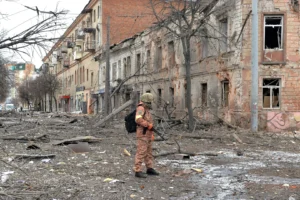Ever since the “flight shame” movement began encouraging travelers to seek greener alternatives to jet planes, many in Europe have been looking to the continent’s extensive rail network to replace short-haul air travel.
There’s definitely been progress. Airlines including Dutch carrier KLM are entering into rail partnerships on certain routes, while countries like Austria and France are seeking to restrict internal routes where trains are available – although the French decree, which was made law in May 2023, has been significantly watered down from its original premise.
That’s amid a palpable rail revolution on mainland Europe, with new high-speed routes and operators coming online, a reversal in the decline of overnight sleeper services, new tunnel links cutting travel times and new locomotives improving reliability and efficiency. In Spain, Germany and Austria, cheap ticket deals have also played their part.
With so much railway investment, it seems as if the train-ification of Europe’s air transport network is well underway. Surely, it’s only a matter of time before the continent is relying almost exclusively on its iron roadways for getting around and the skies are clearer and greener .
In reality, that remains a distant dream. But why?
As with many efforts to innovate away from environmentally harmful practices, there’s good news and bad news. Fixes are being made, but none of them are quick. And there’s no sign that Europe’s airports are going to get quieter anytime soon.
Symbolic move

The French move has only seen three routes cut — all from Paris Orly airport. – Chesnot/Getty Images
This year got off to a strong start with new legislation promised in France that would ban short-haul flight on a number of domestic routes to help the country cut levels of planet-heating pollution, but though approved by EU officials and then signed into French law in May 2023, the measures are limited in impact.
For the ban to apply, the EU insisted the air route in question must have a high speed rail alternative that makes it possible to travel between the two cities in less than two and a half hours. There must also be enough early and late-running trains to enable travelers to spend at least eight hours at the destination.
This means that ultimately only three routes were culled: those linking Paris-Orly airport to the cities of Bordeaux, Nantes and Lyon. In a further blow to those hoping for a rail revolution, it turned out that, as it happened, those routes had already been cut in 2020 – the new law just means that they will not be reinstated in the future.
So what went wrong? The ruling by the EU’s European Commission watered down the original French plans, which would have seen a further five routes ending: From Paris Charles de Gaulle Airport to Bordeaux, Nantes, Lyon and Rennes, as well as a Lyon to Marseilles route.
The result, say critics, is something that pays lip service to climate concerns without really doing anything about them.
“The French flight ban is a symbolic move, but will have very little impact on reducing emissions,” Jo Dardenne, aviation director at cleaner transport campaign group Transport & Environment (T&E), told CNN before the law took effect.
T&E has estimated that the three routes affected by the ban represent only 0.3% of the emissions produced by flights taking off from mainland France, and 3% of the country’s domestic flight emissions (again counting only mainland domestic flights).
If the five additional routes that the French authorities wanted to include were added, those figures would be 0.5% and 5% respectively.
That doesn’t sound like much. But although aviation as a whole currently accounts for around 2.5% of global carbon emissions, its overall contribution to climate change is estimated to be higher, due to the other gases, water vapor and contrails that airplanes emit.
What’s more, it’s a fast-growing industry – despite the pause enforced by Covid – and is on track to be one of the most significant emissions-contributing industries in the future. Aviation emissions in Europe increased an average of 5% year-on-year between 2013 and 2019, according to the EU.
Airlines pay zero tax or duty on their fuel in the EU, unlike other forms of transport. Plane tickets are also exempt from VAT.
More restrictions to come

Deutsche Bahn and Lufthansa offer linked journeys via rail and air. – ulian Stratenschulte/picture alliance/Getty Images
On the positive side, despite its limited impact, the French ruling sets a precedent that will be difficult to ignore by the aviation industry at a time when it’s coming under ever increasing scrutiny from the public, as well as politicians.
“The French measure is so marginal in its current scope that it is sustainability theater rather than having any material impact on emissions,” Patrick Edmond, managing director of Altair Advisory, an Ireland-based aviation consultancy told CNN – again before the law took effect.
“However we can look at it a different way – as the harbinger of more restrictions on aviation which are likely if the industry doesn’t get more serious about decarbonizing itself.”
France isn’t the first European country to take a tougher line on super short-haul flights.
In 2020 the Austrian government bailed out the national carrier, Austrian Airlines, on the condition that it axed all flights where a rail journey could take less than three hours.
In reality, only the Vienna-Salzburg flight route was cut, with train services increased on the line in response. A similarly short route, from Vienna to Linz, had been moved to rail in 2017.
That same year, the government also launched a 30 euro ($32) tax on all flights of under 350 kilometers (220 miles) departing from Austrian airports.
Other European countries are said to be considering curbs on short-haul commercial flights as well – a move that could be welcome, since 62% of European citizens would support a ban on short-haul flights, according to a 2020 survey. Spain has outlined plans to cut flights where train journeys take less than 2.5 hours by 2050.
Not surprisingly these moves have set alarm bells ringing in the aviation industry.
According to a 2022 report commissioned by the European Regional Airlines Association (ERA) together with a number of other aerospace industry bodies, if all airline traffic on routes of under 500 kilometers (310 miles) switched to another form of public transport, the potential carbon savings would total up to 5% of intra-EU emissions.
“For many decision-makers, banning short-haul flights and showing support to the rail industry is an easy win to gain favor with the public, especially in Europe,” Montserrat Barriga, the ERA’s director general, told CNN.
But Barriga and others – on both side of the issue – point to the double standard of restricting short-haul flights and phasing out carbon allowances for flights in Europe while taking no major steps to limit connections outside the bloc.
Long-haul flights produce the most emissions globally. A recent academic paper in the Journal of Transport Geography found that while flights of under 500 kilometers (310 miles) account for 27.9% of departures in the EU, they represent only 5.9% of fuel burnt. In contrast, flights longer than 4,000 kilometers make up just 6.2% of departures from the EU, but 47% of fuel burnt.
“Governments continue ignoring the biggest source of aviation emissions – long-haul flights, that remain unpriced and unregulated,” says T&E’s Dardenne. “Flight bans shouldn’t be used by governments as a distraction from the real problem.”
Obstacles to switching

Europe’s train network is connected by spectacular stations, like Paris Gare de Lyon. – Tanya Keisha/Adobe Stock
And while railways are currently blazing fresh trails through Europe, playing a part in the recent collapse of Alitalia, Italy’s national airline, rail operators could do more, says Jon Worth, founder of public advocacy group Trains for Europe.
High prices and low frequencies remain an obstacle to getting more people to switch from flying, he says – especially on trunk routes like Paris to Amsterdam, Frankfurt and Barcelona.
“On quite a few corridors, rail could get a share of multimodal transportation way above the current one. Rail operators have focused on maximizing profit rather than market share. The latter can only be achieved either by running railways as a public service or by introducing more competition,” he says.
Better connectivity between intercity rail and airports would also reduce the need for short-haul flights. Worth adds that it’s essential to offer combined tickets, so that, for example, if a train is delayed and the connection is missed, travelers are accommodated on the next one, as happens now with connecting flights.
This works rather well in countries where airlines and operators cooperate, including Germany, Austria, France, Switzerland and Spain. In February 2023, Italian airline ITA Airways – Alitalia’s successor – signed on to work with Italy’s national rail operator to create links, too.
However, this is an area where there is still much to be done – for starters, the schemes above are limited to the national carriers. A proposed piece of legislation called Multimodal Digital Mobility Services is expected to be adopted by the European Commission in 2023 with the aim to facilitate this type of intermodal travel more widely.
Back in France, shorter train travel times and increased frequencies may mean the end of the line for more domestic air routes when the ban comes up for review – the measure is only valid for three years. However, advances in clean flight technology may eventually change the perspectives for regional aviation as well.
Short-haul flights are likely to be the first segments of the aviation industry to decarbonize since most of the projects under way in the fields of electric, hybrid-electric and hydrogen-powered aviation focus precisely on small airplanes designed to cover very short distances.
The debate looks set to continue playing out over the next few years, as the environmental, social, economic, political and technological parameters that shape this discussion continue to evolve – and as the climate crisis continues.
Source : Yahoo











